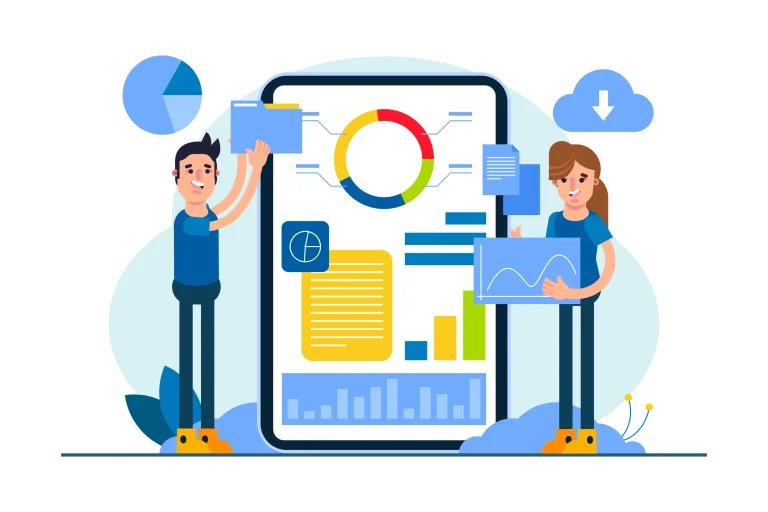Can Data Analytics Help You Grow During a Downturn? Yes, Here’s How

Introduction
Economic downturns are every business leader’s nightmare. Sales decline, consumer behavior shifts, and budgets get tighter. While some companies freeze operations or cut costs blindly, others take a smarter path—leveraging data analytics to gain insights, adapt strategies, and drive growth even in uncertainty.
Data analytics isn’t just a luxury reserved for boom times. In fact, when the economy slows down, it becomes one of the most critical tools for survival and transformation. In this blog, we’ll explore how data analytics can help your business not just stay afloat but grow strategically during a downturn.
1. Understanding What Data Analytics Brings to the Table
Data analytics refers to collecting, processing, and interpreting data to support better decision-making. It includes tools and techniques like:
- Descriptive analytics(what happened),
- Diagnostic analytics(why it happened),
- Predictive analytics(what could happen),
- Prescriptive analytics(what should we do next).
In a downturn, businesses often don’t have room for trial and error. Data helps eliminate guesswork and provides clear, fact-based direction.
2. Spot Hidden Cost-Saving Opportunities
When revenue slows down, cutting unnecessary costs becomes essential. But how do you identify what to cut without hurting business operations?
Data analytics reveals operational inefficiencies. For example:
- Supply chain analysismight highlight delays or overstocking in certain locations.
- Customer service datacan show which processes can be automated or streamlined.
- Sales datamay reveal underperforming SKUs that can be removed or repriced.
By using data, companies can make surgical cuts—not hacksaw decisions—preserving growth potential while reducing waste.
3. Improve Customer Retention Through Behavioral Insights
During downturns, acquiring new customers becomes harder and more expensive. Retaining existing customers is far more cost-effective—and data analytics helps make that happen.
Here’s how:
- Customer segmentationhelps tailor marketing and service approaches to different customer types.
- Churn prediction modelsuse historical data to identify which customers are most likely to leave.
- Feedback analyticsfrom surveys, reviews, and support tickets can highlight areas for product or service improvement.
With these insights, businesses can build personalized retention strategies, improving loyalty and lifetime value even when consumer spending declines.
4. Optimize Marketing Spend
Marketing budgets are often the first to be slashed in a downturn. However, cutting without insight can do more harm than good.
Data analytics enables ROI-driven marketing by helping you:
- Identify the most effective marketing channels(email, paid search, organic, etc.).
- Optimize campaign timing and messagingthrough engagement analytics.
- Use lookalike modelingto target prospects most similar to your top-performing customers.
Instead of wasting money on broad, uncertain campaigns, analytics empowers you to spend less but smarter—getting better results from limited resources.
5. Predict Market Trends and Demand
Predictive analytics can help you anticipate changes in customer behavior or market conditions. For example:
- An e-commerce platform might use predictive models to forecast demand for specific products in certain regions.
- A manufacturer can use weather, commodity, and shipment data to predict supply chain disruptions.
This foresight allows businesses to respond proactively instead of reactively—stocking the right products, shifting resources, or changing offerings to match evolving demand.
6. Enhance Agility Through Real-Time Dashboards
When things are changing fast—as they do during downturns—real-time data becomes crucial. Dashboards allow leadership teams to track KPIs such as:
- Revenue per region or product
- Website traffic and conversion rates
- Inventory turnover
- Customer satisfaction scores
With these live insights, businesses can make quick, informed decisions, pivot strategies instantly, and outpace competitors who rely on outdated reporting cycles.
7. Data-Driven Innovation and Product Development
A downturn can be the perfect time to reimagine your offerings. But how do you know what customers actually want or need right now?
Data analytics enables innovation grounded in demand:
- Usage datashows how customers are interacting with your product.
- Gap analysisidentifies unmet customer needs.
- A/B testinglets you experiment with new features, pricing, or formats.
This approach helps businesses create value-driven products or services that solve real problems—gaining traction even in tough times.
8. Improve Workforce Productivity and Morale
Economic stress can hit internal teams just as hard. Data analytics can help managers optimize workforce planning and employee engagement by:
- Tracking productivity across teams or individuals.
- Identifying overworked or underutilized employees.
- Measuring the impact of remote or hybrid work models.
Using HR analytics, companies can also tailor training programs, balance workloads, and boost morale—ensuring that the team remains productive, aligned, and motivated during adversity.
9. Risk Management and Fraud Detection
Downturns can increase business risks, from supply chain fraud to financial default. Advanced analytics tools can:
- Detect anomalies in transactions or behavior.
- Assess vendor and customer risk profiles.
- Simulate scenarios for stress testing.
This makes it easier to manage risk proactively rather than suffer costly surprises. It also builds resilience that extends beyond the downturn.
10. Create a Culture of Data-Driven Decision-Making
A final but crucial benefit using analytics during a downturn helps embed a data culture across the organization. When teams see the power of data in driving results under pressure, they’re more likely to embrace it long-term.
From leadership to frontline staff, this culture shift enables faster adaptation, smarter strategy, and ongoing competitive advantage even after recovery.
Conclusion: In Data We Trust
Economic downturns may test your business—but they don’t have to break it. With the right data analytics strategy, you can identify opportunities, optimize operations, retain customers, and even innovate while others are pulling back.
In times of crisis, data becomes more than a tool—it becomes a compass. Businesses that understand how to read and act on this compass are not just better equipped to survive—they’re poised to emerge stronger on the other side.
So, can data analytics help you grow during a downturn?
Absolutely. And now’s the perfect time to start.
Key Takeaways:
- Use data analytics to cut costs without compromising value.
- Retain more customers with personalized insightsand churn analysis.
- Spend marketing budgets smarter using ROI-focused strategies.
- Predict demand shifts and customer needs with predictive analytics.
- Encourage organization-wide data-driven decision-making for long-term resilience.
Table of content
- Introduction
- 1. Understanding What Data Analytics Brings to the Table
- 2. Spot Hidden Cost-Saving Opportunities
- 3. Improve Customer Retention Through Behavioral Insights
- 4. Optimize Marketing Spend
- 5. Predict Market Trends and Demand
- 6. Enhance Agility Through Real-Time Dashboards
- 7. Data-Driven Innovation and Product Development
- 8. Improve Workforce Productivity and Morale
- 9. Risk Management and Fraud Detection
- 10. Create a Culture of Data-Driven Decision-Making
- Conclusion: In Data We Trust
- Key Takeaways:










